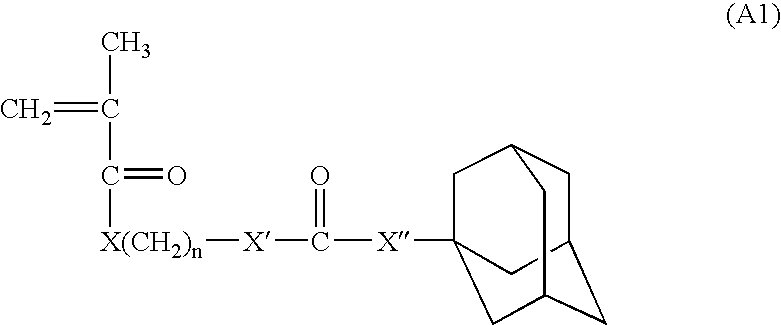Imageable members with improved chemical resistance
a technology of imageable elements and chemical resistance, applied in the field of negative and positive working imageable elements, can solve the problems of time-consuming use of masks, and achieve the effects of improving thermal bakeability, increasing “chemical resistance”, and resisting breaking down
- Summary
- Abstract
- Description
- Claims
- Application Information
AI Technical Summary
Benefits of technology
Problems solved by technology
Method used
Image
Examples
example 1
Positive-Working Single-Layer Imageable Elements
[0234]Single-layer imageable elements were prepared by dissolving the ingredients for Formulations 1, 2, 3, 4, 5a and 5b shown in the following TABLE I in the solvent. For comparison, Formulations 1, 2 and 3 contained about 10% solvent resistant binder (Polymers A–C) while Formulations 4, 5a and 5b did not include these binders.
[0235]
TABLE IFormulation 1Formulation 2Formulation 3Formulation 4Formulation 5aFormulation 5bIngredient(wt %)(wt %)(wt %)(wt %)(wt %)(wt %)LB656430.640.130.663.363.363.3PD494000024.824.8Durez 3381643.433.943.424.8——InventivePolymer APolymer BPolymer C2.0*2.0*2.0*Polymer(10.2)(10.2)(10.2)XDSA5.65.65.65.5——Basonyl violet1.91.91.91.922KF654b0.50.50.50.50.50.5IR Dye A1.41.41.41.41.01.0Silikophen666666P50XByk ® 3070.40.40.40.40.40.4Weight %Weight %Weight %Weight %Weight %Weight %Dioxolane65MEK6565602020PGME151510801580BLO10103010Water101010*Cellulose acetate hydrogen phthalate (Sigma-Aldrich) is used as solvent resis...
example 2
Positive-Working Multi-Layer Imageable Elements
[0243]Multi-layer imageable elements were prepared as follows:
[0244]Bottom (inner) layer: A coating formulation was prepared by dissolving inventive Polymer (6.0137 g, TABLE III) in a solvent mixture of BLO (9.27 g), PGME (13.9 g), MEK (60.26 g), and water (9.27 g). IR Dye A (1.06 g) was then added to this solution followed by BYK® 307 (0.211 g). The resulting solution was coated onto an aluminum substrate to achieve a 1.5 g / m2 dry coating weight.
[0245]Top (outer) layer: A coating formulation of P-3000 (1.5025 g), PD-140 (3.4685 g), ethyl violet (0.014 g), BYK® 307 (0.149 g) in DEK (85.38 g) and acetone (9.48 g) was coated over the bottom (outer) layer to give a dry coating weight of 0.5 g / m2.
[0246]The imageable elements were thermally imaged on a conventional Creo Trendsetter 3244 (Creo Products, Burnaby, BC, Canada) having a laser diode array emitting at 830 nm with a variety of exposure energies from 80 to 140 mJ / cm2. The exposed ele...
example 3
Positive-Working Multilayer Imageable Elements
[0254]Multilayer imageable elements were prepared as follows:
[0255]Bottom (inner) layer: A coating formulation was prepared by dissolving an inventive Polymer (6.0137 g, TABLE IV) described above in a solvent mixture of BLO (9.27 g), PGME (13.9 g), MEK (60.26 g), and water (9.27 g). IR Dye A (1.06 g) was then added to this solution followed by BYK® 307 (0.211 g). The resulting solution was coated onto an aluminum lithographic substrate to achieve a 1.5 g / m2 coating weight.
[0256]Top (outer) layer: A coating formulation of P-3000 (1.5025 g), PD-140 (3.4685 g,), ethyl violet (0.014 g), BYK® 307 (0.149 g) in DEK (85.38 g) and acetone (9.48 g) was coated over the described bottom (inner) layer to give a coating weight of 0.5 g / m2.
[0257]The resulting imageable elements were thermally imaged on a Creo Trendsetter 3244 (Creo Products, Burnaby, BC, Canada) having a laser diode array emitting at 830 nm with a variety of exposure energies of from 1...
PUM
| Property | Measurement | Unit |
|---|---|---|
| weight % | aaaaa | aaaaa |
| weight % | aaaaa | aaaaa |
| weight % | aaaaa | aaaaa |
Abstract
Description
Claims
Application Information
 Login to View More
Login to View More - R&D
- Intellectual Property
- Life Sciences
- Materials
- Tech Scout
- Unparalleled Data Quality
- Higher Quality Content
- 60% Fewer Hallucinations
Browse by: Latest US Patents, China's latest patents, Technical Efficacy Thesaurus, Application Domain, Technology Topic, Popular Technical Reports.
© 2025 PatSnap. All rights reserved.Legal|Privacy policy|Modern Slavery Act Transparency Statement|Sitemap|About US| Contact US: help@patsnap.com



